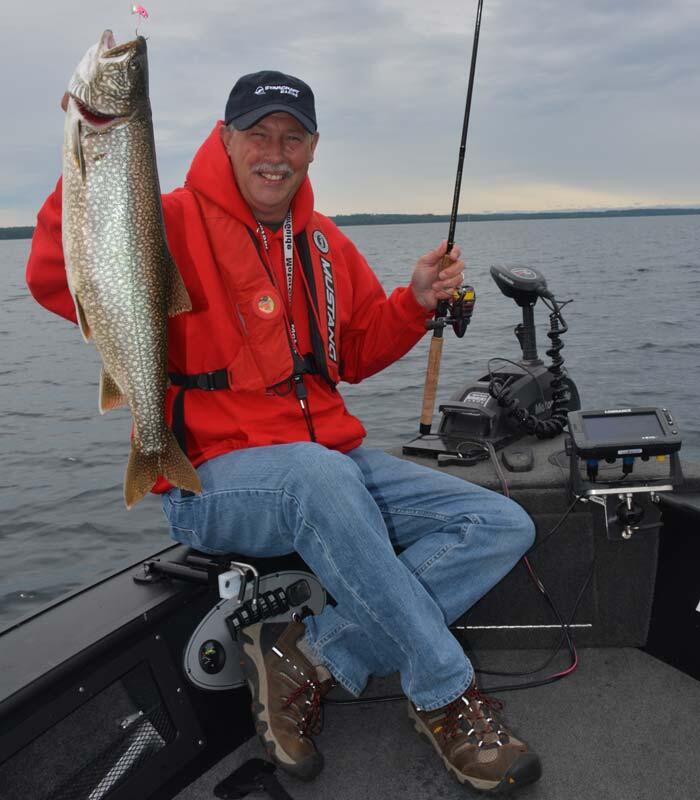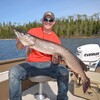
In Search of Grays

The lake trout is no exception, and this unique species goes by some pretty colourful names, including denizen of the deep, mackinaw, siscowet, lake char, touladi and my favourite, the gray trout.
The gray trout, or just gray for short, inhabits clear, cold and deep-water lakes all across the Northern United States and Canada. In Ontario's Algoma Country, grays can be found on Lake Huron and Lake Superior as well as in a host of inland lakes.
Compared to other trout and char species, the lake trout grows much larger. Fish in the 20-pound class are fairly common, and every year, anglers boat fish in the 30, 40 and sometimes even 50-pound class! The Ontario record for lake trout is a whopping 63 pounds caught near Isle Royale.

Trolling Bottom
Well known as a structure or bottom-loving species, one of the most effective ways to target grays is to troll near the bottom with the help of a downrigger. Spoons, plugs and spinners will all catch grays, but hands down the most deadly bottom rig for trolling up these fish is a rig known as the dodger and Spin-n-Glo. The dodger is an attractor that is rigged about 18- to 24-inch in front of a Yakima Bait No. 2 or 0-size Spin-n-Glo body. The Spin-n-Glo is threaded onto a 20- to 40-pound test leader, a bead or two is added to make it easier for the Spin-n-Glo to rotate, and the rig is completed with either a No. 2/0 single hook or a No. 2 treble hook.
This rig is set behind the boat about 10 to 15 feet, and the line is connected to the downrigger line release. The whole setup is lowered to the bottom and set so the downrigger ball just skips along, churning up clouds of sediment on the bottom.
The cloud of sediment simulates lake trout naturally feeding on the bottom. The trailing dodger and Spin-n-Glo rig close the deal. This simple setup has literally produced countless lake trout anywhere they are found, feeding on or near the bottom.
The top trout colours on the Spin-n-Glo are the Clown, Pearl Clown, Lime Chartreuse Tiger, Lime Chartreuse and Double Trouble UV Green. On the dodger, most anglers favour a silver, brushed stainless steel, chartreuse or green/chartreuse colours.
The Spin-n-Glo can be purchased pre-rigged and ready to fish, but most anglers prefer to buy the bodies in packages of 12 and rig their own using fluorocarbon leader material. The Spin-n-Glo comes with white, black, glow, chartreuse, silver and pink wings, creating literally hundreds of colour combinations to experiment with.
Jigging Up Trout
For those who don't own the gear it takes to troll for trout in deep water, jig fishing is another option. To jig up grays in deep water, an angler will need a medium to medium-heavy action spinning rod and reel combo set up with a 10- to 15-pound test super braid terminated to a fluorocarbon leader in the 12- to 15-pound test range.
An eight-strand braid like that produced by Maxima Lines is recommended because this line spools onto a fishing reel much like monofilament. Other braids and fused lines are so soft and without body that the line tends to bunch up on the spool, preventing the reel drag from functioning smoothly.
A functioning drag is essential when a lake trout is hooked up. These fish are stubborn fighters, and typically about halfway to the surface, they make a power run and streak back to the bottom!
Depending on the water depth, jigs in the 1/2, 5/8, 3/4, 1, 1.5, 2 and even 3-ounce range may be required. White or white and red bucktails are popular with trout jig fishermen, but a 5-inch soft plastic paddle tail is another good option. Many anglers tip their jigs with a small live sucker minnow to further entice trout into biting.
Spot Lock Those Fish
Most anglers who fish for lake trout simply drift and keep their jigs near the bottom. If your boat is equipped with an electric motor, it's often better to drift until a fish is hooked, then use the electric motor to hover over the top of the school.
The MotorGuide Xi5 mounted to the bow of my boat has a "spot lock" feature that when engaged, literally hovers the boat in one spot, leaving my hands free to fish. Much better than trying to hover with a traditional electric motor, or worse yet, anchoring in deep water, this piece of equipment is invaluable for jig fishing applications.
With the help of quality sonar, I can literally spot the fish near the bottom, put the boat in "Spot Lock" mode and drop my jig right down to specific fish. I call this "see fish... catch fish" because it's amazing how often I can spot an individual fish and then catch that fish with the help of sonar and an autopilot-style electric motor!

Summing It Up
Grays are one of those fish you can only catch in the north. These fish require cold, pristine waters, and Ontario's Algoma Country is at the top of the list when it comes to destinations teaming with hungry trout.
Recommended Articles

The Group of Seven in Algoma

9 Facts to Know about the Agawa Canyon Tour Train






























